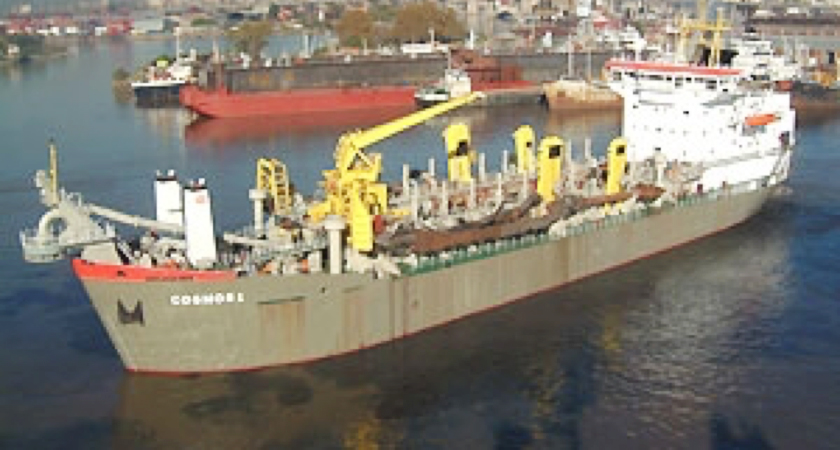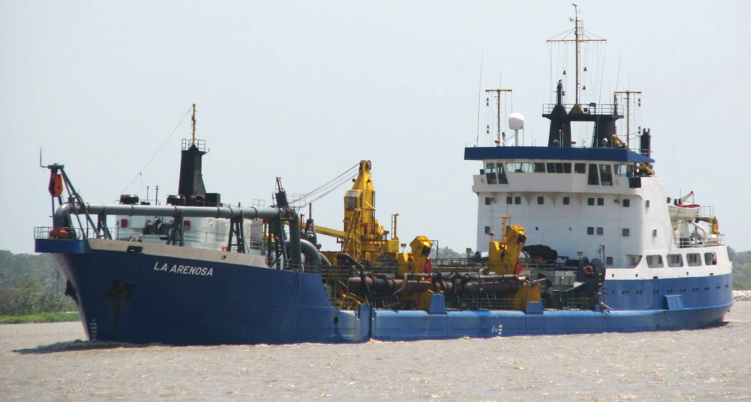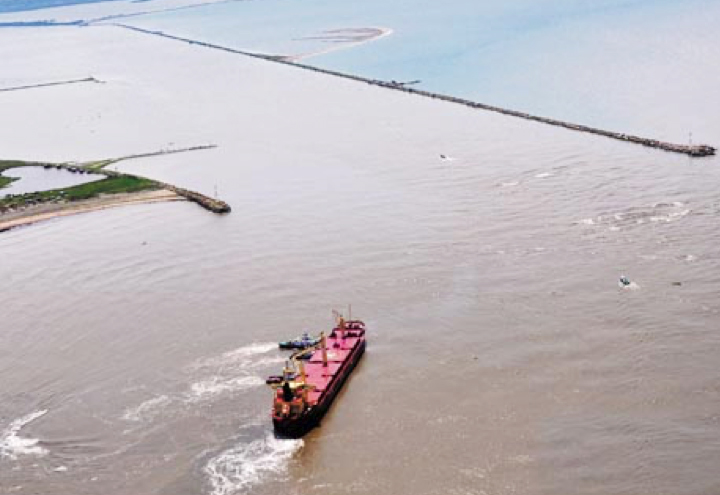Taking into account that the Magdalena River dredging contract was awarded to the new European; We publish an Editorial review of the article written by Enrique Lequerica Otero for corrupcionaldia.com regarding dredging contracts and corruption in Colombia.
Facing the constant “crisis” of the seaports (we are talking about the 40s), and with no major alternative solutions, our grandparents said as they do today, we need a permanent dredge for the maintenance of the port and therefore, the central government brought the first dedicated dredge, which was available until the mid-90s.
Between 1946 and 1947 the Ministry of Public Works moved to Barranquilla the dredge DH-3 or DH-4 (?), of which there is only mention of the record of its capacity: 1,000 cubic yards (760,000 cubic yards). It is estimated that it was a suction and cutter dredge with floating pipe discharge, which carried out its first works seeking to increase the draft of the Port, however, this solution was not enough. It was necessary to try to help with greater river speed by contracting the distance between the Tajamares from 800 to 610 meters and favoring the displacement of sediments so that they would not accumulate in the channel.

In 1955, Gabriel García Márquez wrote an extensive report entitled “Viacrucis de Bocas de Ceniza”, which was published in three installments by El Espectador and dealt with the deterioration of one of the ports that enjoyed the prestige of being one of the largest landing docks in 1893 and that by 1955 was found as a ruined iron and wood platform. Also in his investigations, he confirmed that the “brand new and unserviceable Barranquilla dredge” (the DH-4?) was acquired, which he described as “a pile of old iron that any day could be auctioned off without losing anything other than a considerable sum of money”. Today we can assume that the dredger was not suitable for this type of work.
Under the advice of Sir Alexander Gibb & Partners, the Colombian State in 1964 opened public bidding for the purchase of a suction dredge underway with a hopper. The tender was awarded to Royal IHC and was built in 1967, named “Colombia” with IMO number 6714603; the dredge, a piece of modern equipment and apparently in accordance with the needs of Barranquilla, of 79 meters in length, 11.9 meters of beam and a maximum draft of 4.6 meters, has a capacity of 1. 020 m3 of hopper-fed by a 0.65 meters diameter suction arm capable of dredging to a depth of 15 meters. A solid piece of equipment that remains active after 50 years of service.

However, in 1972, the Bocas de Ceniza office under the direction of the well-remembered Engineer Jorge Borda Palma, presented to COLPUERTOS management an analysis in which he demonstrated that “the dredging of the Bocas de Ceniza maritime channel, carried out by the “Draga Colombia” had not been as successful as it could have been expected” and he explained it technically as follows:
Again we see how the dredge selected was not the most adequate, and soon became insufficient to attend Bocas de Ceniza and the entire navigable channel.
In 1971 several important events occurred; the largest flood in the last 60 years at that time, which resulted in a process of marginal erosion in the Siape sector and widening of the hydraulic section of the Magdalena River (later identified as La Niña phenomenon) flooded the channel, reaching at certain points Via 40 (today the Naval NCO School) and the piling of the Laureano Gomez Bridge at K22 began; in 1972 with the low water level, the river showed its modifications: the displacement of the navigable channel towards the right arm of the river, and creating the 1972 island that became a major headache until the mid-1990s. The riverbed was destabilized to such an extent that in the mid 1980s, COLPUERTOS decided to acquire a second suction dredge underway, the “BOCAS DE CENIZA”, (ex COSMOS) with IMO number: 7917214. The 113.6 meters long dredge, 20 meters wide and with a maximum draught of 8.2 meters, had a hopper-fed capacity of 5,854 m3 by two 0.8 meters diameter suction arms capable of dredging up to 32 meters deep. A tremendous piece of equipment, the best we have ever had for the Port, and which helped a lot to maintain the Port during its unstable channel season until the construction of the Directional Dock in 1994.

When COLPUERTOS was liquidated, the two dredges were delivered to a private operator, the ill-remembered DRAGACOL that operated them indiscriminately, neglected the maintenance until the State declared itself unable to take charge of the equipment and auctioned them through public auctions; now that it had a piece of proper equipment, the Ministry of Transportation got rid of it like a contaminated dress, and Barranquilla was left since 1996 without a permanent dredge. From that time until 2004, major dredging was contracted with foreign dredges, the remembered Chinese and Mexican dredges, which inaugurated the system of appearing, making corrective dredging and charging heavily; logically after having left, sedimentation and channel closures began to appear again.
In order to keep its growing business in operation, in 2004 the SPRB took the decision to purchase the suction dredge in operation, “LA ARENOSA” (ex “Resolution”) with IMO number 7118521, built in 1972 with 118 mtrs length, 18 mtrs beam and 7.9 mtrs draft at full load, it had a hopper of 4,600 m3 fed by 2 suction pipes of 0.9 mtrs diameter capable of dredging up to 25 mtrs depth.

This SPRB policy was not due to an altruistic act or a whim, but to a reasoned cost/benefit exercise, where even punishing its operating costs, the final balance was compensated by the benefits of handling larger cargo volumes; unfortunately, there was no synergy with the other terminals and no support from the local and national leadership.
In 2008, the SPRB acquires a second suction dredge underway the “VIRGEN DEL ROCIO” with IMO number 6600046, built in 1966 but rebuilt in 2003 with a length of 72.52 mtrs, beam of 12.65 mtrs and full load draft of 5.4 meters, it had a hopper of 1,300 m3 fed by a 0.75 mtrs diameter arm capable of dredging up to 18 mtrs deep.

When reviewing the precarious dredging statistics for the Barranquilla navigable channel, between 2004 and 2010, low expenditures were found due to preventive dredging performed by SPRB’s dredgers, many times without charging and when they did charge, it was always below USD 2.50 m3.
The winter wave associated with the 2010-2011 La Niña Phenomenon had been cataloged as one of the worst natural disasters in the history of Colombia, causing considerable damages, civil and economic losses. For the Maritime Ports, it was a real nightmare, between August 2010 and December 2011 there were 18 major incidents, 14 of them groundings near Bocas de Ceniza, as a result of never before measured flows, discharge velocities above 3 m/sec, and an unusual growth of the Barra that forced to vary the approach angles for entry through Bocas de Ceniza. The limited local dredges were unable to overcome the prevailing conditions, and it is possible that many of the larger, more modern dredges would not have been able to operate in such extreme conditions either.


The extreme winter event changed many things and revealed the lack of commitment of most of the entities in charge of managing the Barranquilla Seaport. Prevention was conspicuous by its absence on all fronts; the first major stranding occurred in August 2010, when the extreme La Niña phenomenon was already a forewarned fact and did not produce reactions. Only in July 2011 was a declaration of manifest urgency given. “Perplexity and indignation are what most of the people of Barranquilla feel when they witness the indifference and laziness with which the Minister of Transportation treats the issues related to the access channel” declared a recognized political leader.
In September 2011 the national government issued Decree 3222/2011 declaring the freedom of flag for dredging operations and giving a certificate to the incipient Colombian dredging companies with suction equipment in operation, a situation that still prevails today.
Since then, national dredging has been concentrated in the hands of large European dredging companies, with bidding processes of very debatable structuring and where final costs do not go below USD 6.5 m3. Preventive dredging was forgotten and the possibility of complementary dredging works was forgotten. In the case of the navigable channel of the Maritime Ports of Barranquilla, the matter is degrading, because the responsibility for dredging has been alternating between INVIAS and CORMAGDALENA, without much memory and where the final reports of the auditors are so brief that they are really embarrassing.
Talking about dredges has invaded all social networks among the Barranquilla community, to such an extent that it makes me evoke the 80s. Today, there is profuse talk about suction dredges on the go with hoppers, as if they were different models of cell phones, forgetting that the dredge is a very specialized tool, requiring a good operator and a well-stocked toolbox to complement it.
Perhaps the closing question is: What to dredge? The answer can be found when acting as a community, We are clear about the context of the problem, remembering the experiences already lived, stopping port planning by media and social networks, identifying our needs to be satisfied, and only then, by consensus, we will respond by proposing the actions to be taken.
Editorial
Even though Enrique Lequerica presents a historical review since the 40s up to late 2011, the relationship between dredging and corruption is not addressed. Furthermore, as dredging is a consequence derived from the erosion of particles that are swept by river currents, stating a consensual solution for a dredge will never solve the problem. A holistic consideration of the river as an environmental body, to calculate one-dimensional steady flow, one and two-dimensional unsteady flow calculations, sediment transport/mobile bed computations, and water temperature/water quality modeling would provide better information in order to use the right dredge for the job. Finally, the reforestation of its river banks to minimize erosion in order to reduce the amount of sediment to be dredged.

